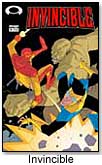The differences between graphic novels and comic books are quickly distinguishing graphic novels as the preferred form of media for sequential art. Enter a major bookstore such as Borders or Barnes & Noble, and its "Graphic Novel" section may be as large as its "Mystery" or "Science Fiction" counterparts.
 In previous years, graphic novels were ignored and relegated to the Humor section, or often, not stocked at all in bookstores or libraries, despite their enormous popularity with children and young adults. Independent graphic novels edged onto the literary scene, with Art Spiegelman, Daniel Clowes, and Adrian Tomine grabbing attention and accolades from the mainstream press in the early nineties with stories of ordinary people coping with the rigors of everyday life or, in the case of Spiegelman, the horrors of the Holocaust retold using animal characters.
In previous years, graphic novels were ignored and relegated to the Humor section, or often, not stocked at all in bookstores or libraries, despite their enormous popularity with children and young adults. Independent graphic novels edged onto the literary scene, with Art Spiegelman, Daniel Clowes, and Adrian Tomine grabbing attention and accolades from the mainstream press in the early nineties with stories of ordinary people coping with the rigors of everyday life or, in the case of Spiegelman, the horrors of the Holocaust retold using animal characters.
As the popularity of these independent, quirky works grew, so did the medium, which provided numerous advantages over the comic serial. According to Don Wynnewood, owner of Don´s Atomic Comics and Collectibles, the advantages include affordability (since a single book costs less than a stack of individual 32-page floppy comics), convenience and a lack of ads. Most important, he said, graphic novels “are excellent pieces of art and literature that are traded! Hugo Award winners, Pulitzer Prize recipients, Easers, Harvey´s, etc. There are some amazing pieces of work in the sequential art medium. You´ve just got to look."
The mainstream comics industry took note and began repackaging many of their titles in graphic novel form. Hollywood noticed, too: United Artists turned “Ghost World” by Daniel Clowes into a commercially and critically successful movie. “Sin City” by Frank Miller was a daring piece of work that showed off the cinematic quality of the graphic novel medium. Robert Rodriguez co-directed with Miller and was so faithful to Miller´s vision that images from the graphic novel were duplicated in the film.
With financial success, critical acclaim and popularity soaring, retailers and publishers are finding the demand for graphic novels hard to ignore. They are also harder to dismiss as "child´s play," when a large percentage of consumers are adults.
Graphic novels have a familiar appeal to the mainstream consumer. The graphic novel feels like a "real book." According to Jim Demonakos, public relations and marketing coordinator for Image Comics, "Graphic novels are much more acceptable to the mainstream buyer because they´re square-bound and are much more like novels."
Unlike single-issue newsprint comics, graphic novels are often of better paper quality and have additional features, such as artist interviews, star introductions and can be found in either paperback or hardcover format. Waiting for the publication of the graphic novel may also prove to be more cost-effective and less of a hassle than buying every single-issue newsprint of a beloved comic.
With the change in format came an expansion in the possibilities of the comic world. Lee Dawson, publicist for Dark Horse Comics, told TDmonthly, "The popularity of manga, especially for young women and girls, is connected with the success of the graphic novels being sold today."
Manga´s success has "bled over into the comics industry," and the comics world is finding that it can expand beyond superhero tropes to a wide range of possibilities. The added space gives comics artists more license to experiment with stories, format, and tell stories the way they envision it.
Demonakos went on to say that, "People want more variety from their comics, just like movies: The summer blockbuster is fun, but the drama, the foreign film, the horror flick — all have their place and audience."
Here are a few examples of graphic novels and comics to watch:
.
.
.
.

